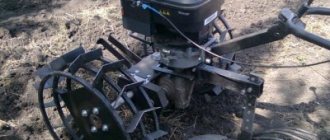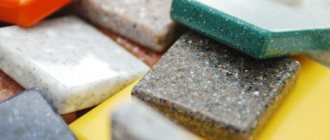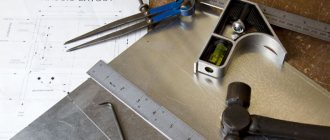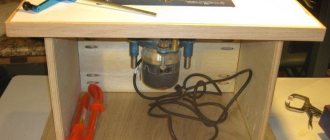10/23/2019 Author: VT-METALL
Issues discussed in the material:
- What is sheet metal cutting?
- What are the industrial types of sheet metal cutting?
- What tools can be used to cut sheet metal manually?
- What mechanical methods exist for cutting sheet metal?
- What is the principle of cutting sheet metal with a grinder and guillotine?
The quality of metal processing depends on many parameters: the technology used, the performance of the equipment, the skills of the craftsman, the characteristics of the raw materials, etc. Today in the article we will tell you that high-quality cutting of sheet metal is possible not only in production, but also at home, and We will also consider the main nuances of using the most popular equipment.
Industrial types of sheet metal cutting
Metal processing can be carried out in different ways. The specifics of the work depend on the type of equipment used for cutting metal sheets.
At large industrial enterprises, waterjet or thermal cutting is most often used.
1. Heat treatment of sheet metal.
Thermal cutting involves separating metal sheets with a jet heated to extreme temperatures. This type of cutting is also called non-contact cutting, since the tool does not interact with the surface of the sheet material.
Types of thermal cutting: oxygen gas, laser, plasma.
- Oxygen gas cutting of sheet metal.
Oxygen gas processing of sheet metal includes two stages:
- A jet of flame coming out of the cutter is supplied to the starting point of the intended cutting line. Acetylene is used as the working gas.
- After heating the material, the device supplies an oxygen flow, which easily cuts the softened metal. At the same time, oxides are removed.
In order for the cutting quality to be high, the distance between the cutter nozzle and the metal must be the same throughout the entire working process.
We recommend articles on metalworking
- Steel grades: classification and interpretation
- Aluminum grades and areas of their application
- Defects in metal products: causes and search methods
Oxygen cutting is the most economical cutting method and is excellent for cutting low alloy steels. If all the nuances of the technology are observed and the craftsman has sufficient experience, the edge of the sheet metal after oxy-fuel cutting does not require additional processing.
The disadvantage of using this type of cutting is that it can only process metals with low thermal conductivity.
- Plasma cutting of sheet metal.
Plasma cutting is considered a more universal method of processing sheet materials. The first equipment for this type of metal cutting appeared in the second half of the 20th century. The equipment was not only bulky, but also expensive, and therefore only large industrial enterprises could afford its acquisition and use. Over time, equipment has become more accessible, and the popularity of plasma cutting has grown exponentially.
VT-metall offers services:
In this case, metal processing is carried out using a high-speed plasma flow, the temperature of which can reach +30,000 °C. In this case, drops of molten metal formed as a result of melting are instantly blown away by a stream of compressed air. Compared to the previous type of cutting, plasma processing is highly productive, because the temperature of the oxygen gas flow is only +1,800 °C.
It is worth noting that the popularity of plasma cutting is explained not only by its high productivity, but also by a number of other important parameters. Thus, the work process does not require regular refilling of gas cylinders, additives for cutting valuable metals or increased attention to fire safety measures. To work with plasma equipment, you only need electricity and air, which allows you to draw objective conclusions about the simplicity, convenience and economy of the work process.
Plasma cutting of sheet metal can be used to process:
- aluminum and alloys based on it up to 120 mm thick;
- copper up to 80 mm thick;
- alloy and carbon steels up to 50 mm thick;
- cast iron up to 90 mm thick.
If the metal thickness exceeds 120 mm, it is more advisable to use oxy-fuel cutting.
When selecting the optimal equipment for metal processing, it is very important to take into account such properties as thickness and thermal conductivity. Here you need to remember one simple rule: the higher the thermal conductivity of the material being cut, the greater the heat removal and the smaller the possible thickness of the sheet being processed (for example, the thickness of a copper sheet should be less than a stainless steel sheet).
Advantages and disadvantages of threaded connections
Among the advantages of threaded connections it is worth highlighting:
- the possibility of obtaining a high-strength detachable unit;
- unified design of hardware and thread-cutting tools;
- ease of connection of threaded components;
- long service life of the created connections;
- the ability to perform work with moderate load on the tool.
The disadvantages of threaded connections include a tendency to “sour”, as well as the need for special tools for installation and dismantling operations. When working with certain types of connections, groovers are used to prevent arbitrary unwinding of the components, as well as large washers that distribute clamping forces.
Tools for hand cutting sheet metal
Manual cutting of sheet metal cannot be called highly effective, so most often it is used only at home.
In the process of cutting sheet metal, the following tools are used:
- Scissors. Using hand scissors, you can process metal sheets whose thickness does not exceed 3 mm. There are several types of similar devices suitable for cutting metal:
- For straight cuts.
- For curvilinear.
- Finger (straight and mirror type) - used to obtain complex figures.
- With one movable blade, and the second fixed, fixed to the workbench.
- Hacksaw.
- Jigsaw.
- Bulgarian. This is an angle grinder used for cutting metal, which is operated manually. The main advantages of the grinder are:
- ease of use;
- the ability to process metal sheets of different thicknesses;
- Large selection of replacement disc options.
Thus, manual cutting of metal can be done using scissors, a special machine - an angle grinder or a pipe cutter.
The working elements of a pipe cutter are disc cutters-rollers, which provide convenience and proper speed for cutting cylindrical products.
The quality and speed of manual work largely depend on the experience and skills of the worker.
Devices for manual cutting have low productivity, therefore they are used for metal processing mainly in domestic conditions.
Areas of application for threaded connections
Threaded connections are used in industry and everyday life. With their help, a wide range of problems are solved:
- connection of machine components and mechanisms;
- installation of protective elements in the form of covers, threaded plugs, etc.;
- installation of load-bearing components of metal structures;
- formation of flange connections, which are in demand when laying pipelines;
- installation of machines and other technological equipment.
Threaded connections are indispensable when assembling household appliances and measuring instruments. With their help, modernization and repair work of varying complexity is carried out.
According to their purpose, threads are divided into fastening, running, lifting, and also fastening with simultaneous sealing.
Mechanical types of sheet metal cutting
Mechanical cutting of metal is a contact processing method in which the surface of the tool interacts with the material. The cutting element, as a rule, is also made of metal, but of higher hardness.
The group of devices for mechanical cutting of sheet metal includes scissors, a saw and cutters. A special type of mechanical processing of metal sheets is cutting. Impact cutting or chopping with a guillotine is usually used at the stage of creating workpieces.
Sheet metal machining can also be performed using the following equipment:
- band saw machines (LPS);
- guillotine;
- disk machines;
- lathes with cutters installed on them;
- slitting units.
1. Cutting with a band saw.
It is advisable to use a band saw for processing long metal. This device is the main working element on a band saw machine (LSS). The operating principle of the saw is similar to that of a conventional hacksaw. The saw blade is enclosed in a large diameter band, one side of which has special teeth. Continuous movement of the belt is ensured by rotating pulleys connected to an electric motor. The average operating speed of the LPS is 100 mm/min. The working blade for such machines is usually made of carbon steel or a bimetallic alloy.
The advantages of using LPS include: accuracy, availability, favorable cost of equipment, the ability to perform both straight and angular cuts, efficiency (minimum amount of waste).
Modern machines for cutting sheet metal are equipped with electronics and additional elements, which allows them to be included in the production line if necessary.
Basic process and safety precautions when cutting sheet metal with an angle grinder
Compliance with safety regulations is the most important point, neglect of which can result in injuries of varying severity.
Here are a few rules that should be followed when cutting sheet metal with a grinder.
- Disk size . It is a mistake to believe that its size can be selected without taking into account the size of the angle grinder. Do not install a large blade without a protective cover on a small tool, otherwise you may put your life in danger. The speed of a small grinder is much higher, so they need appropriate cutting elements. Having installed a large disk, you won’t even have time to draw a cutting line; the toothed circle will simply fly apart after turning it on.
- Direction of rotation . Some workers are not satisfied with the direction of sparks that are observed during standard operation of the tool. So they unroll the casing, rearrange the handle, and start cutting. Arbitrariness in this matter can lead to the fact that when caught on a sharp edge, the cutting disk will fly apart into pieces. Remember - the rotation of the disk should be done “towards you”, and not vice versa.
- Personal protective equipment . The presence of such devices is a prerequisite for working with an angle grinder. Safety glasses, gloves and a respirator will help avoid injury to vital organs.
1. Normal cutting of thin sheet metal.
Cutting metal of small thickness usually does not cause any particular difficulties. The key to a high-quality result in this case is attentiveness and accuracy. It is worth noting that when processing thin metal sheets, the cutting disc often “bites.” Before starting work, you need to make sure that there are no defects on the cutting surface of the circle. Their presence can lead to splitting of the toothed disc.
The cutting line should start from the far edge of the sheet (it turns out that the master is, as it were, pulling the grinder towards himself). The cutting disc should not be immersed too deeply into the material (maximum 5-6 mm). The correct direction of movement of the tool and a shallow immersion depth will help to avoid the disc getting caught. And vice versa - excessive immersion of the cutting element will lead to a decrease in the contact area, snags and subsequent splitting of the disc.
2. Cutting thick sheets of metal with a grinder.
If the thickness of the sheet metal is more than 8 mm, then you should move the tool away from you rather than towards you. However, if you simply cut along the drawn line, you will not get a perfectly straight edge. In addition, you can overexert your hand, because you will have to constantly control the movement of the grinder.
To facilitate the work process, installing a steel angle at the cut site, which is pressed against the sheet with clamps on both sides, will help. Now you can walk along the drawn line several times, touching the corner a little so that you get a small indentation (no more than 1-2 mm). After the recess is made, you can remove the corner and proceed directly to metal processing. This way the cutting disc will not leave the intended line, and the edge will be perfectly straight.
3. Another cutting option.
The first stages of the work completely coincide with the method described above: a line is drawn, a corner is laid and pressed. The peculiarity is that the recess in this case is made a little deeper - about 4-5 mm. After removing the corner, the remaining metal can simply be broken off, and the edge can be processed using an angle grinder with a grinding disc. It is worth noting that such processing does not guarantee a high-quality result, so the second method is used much more often.
The grinder allows you to quickly and efficiently process sheet metal, but successful use of this tool is possible only if you have sufficient skills and comply with all safety regulations.
Drilling holes and pre-processing bars
From the last observation we can conclude that the outer diameter of the thread is slightly larger than the original diameter of the rod on which it is cut. Likewise, the axial distance between the tips of the internal threads will be slightly less than the hole.
If you look at any drawing depicting a metric thread, you can note a number of key dimensions:
- Inner and outer diameter. These values change names depending on whether the thread is internal or external.
- Thread pitch is the distance between the tops of adjacent teeth.
- Shape and dimensions of the nominal profile, angles of inclination.
So: the diameter of the rod or thread hole is not equal to either the external or internal diameter of the thread. The easiest way to determine the hole size for an internal thread is to subtract the pitch distance from the outer diameter. For external threads, the same value must be added to the diameter of the rod.
However, real professionals always use tables of standard metric threads, where the recommended diameters also take into account the type of thread, the characteristics of metals and their alloys. So the main problem is finding the right rod or drill.
You set the basis for high-quality cutting at the stage of drilling or preparing the rod. The hole must be drilled strictly perpendicularly; among the ways to control the right angle, you can suggest combining the drill with the reflection in a placed mirror or placing a credit card nearby.
Rust should be removed from the rod and the side surface should be checked for evenness with a metal ruler. The best way to prepare the rod is to clamp it into the drill chuck and give the edge a good file. When rounding, it is allowed to grind the rod down a couple of tenths if this is necessary for alignment, which in practice is more important than the completeness of the cutting.
This is of little use when working with fixed rods. You have to select the thread diameter according to the diameter of the rod, choosing a value less than the recommended one. For a more convenient approach at the end, you need to remove the chamfer and perform the cutting especially carefully and accurately. Do not forget to generously apply machine oil to the area to be treated.
The nuances of cutting sheet metal with a guillotine
Guillotines are used for cutting sheet metal at home or in small factories.
1. What can be cut with a guillotine?
Using a guillotine, you can process metal no worse than using factory equipment. Moreover, craftsmen often make guillotine shears at home.
The most common versions of guillotines are models with a direct movement of the knife and with a change in angle. In the first, the knife moves in a vertical position and allows you to cut sheet metal evenly. The use of models of the second group allows not only cutting sheet metal, but also processing reinforcement bars and large metal angles.
The working capabilities of homemade guillotines are usually limited. This is because, unlike industrial designs, which have different types of drive (hydraulic, pneumatic or electric), a homemade device for cutting sheet metal is usually equipped only with a mechanical lever or pedal mechanism. The depth of cut when using homemade installations depends on the amount of force applied by the master.
Using homemade guillotines you can cut:
- sheets of black and galvanized steel up to 1.5 mm thick;
- stainless steel sheets up to 0.6 mm;
- aluminum;
- plastic;
- cardboard.
When making guillotine shears, you should definitely take into account the type of metal that you plan to process.
2. Operating principle.
Metal cutting using guillotines can be carried out both longitudinally and transversely. Installation options depend on the type of knives installed and their location. When making a cross cut, the knife makes one movement. Longitudinal cutting is accompanied by several movements that will be repeated together with the translational movements of the product. Longitudinal cutting is performed when processing rolls or when it is necessary to cut sheets longer than 2 m.
The guillotine works on the following principle: a sharp knife, under its own weight, is lowered onto a metal surface at high speed. Sometimes the cutting speed or weight of the knife is not enough to cut a certain type of metal or the required thickness. Therefore, the design of the machine is often equipped with an additional element - a lower fixed knife. This setup works like a regular guillotine and scissors.
The presence of an auxiliary element, of course, leads to an increase in the final cost of the equipment, but at the same time it allows you to improve the quality and increase the processing speed of metal parts.
Stages of thread cutting with a machine-hand tap
Work order:
- The first step is marking in accordance with the drawings.
- According to the marks, punching is carried out with a sharply sharpened core.
- Drill with medium pressure at low speeds. The drill should be at right angles to the surface. Before starting work, the drill is lubricated. If the hole depth is large, then lubrication is carried out not only before starting, but also during operation. The depth of the blind hole should be slightly greater than the length being cut. If there is no reserve, the thread may be incomplete.
- The quality of the result can be improved by countersink processing, which reduces the taper and ensures parallelism of the side surfaces.
- The tap is secured in the driver, its tip is lubricated and inserted into the hole strictly at right angles to the surface. Make the first turn, lightly pressing the knob from above. After the first turn forward, make a half turn back to remove chips. Particular care is taken when using a multi-tool - it is fragile and easy to damage. It's easier to work with complete models.
What determines the price of custom sheet metal cutting?
The cost of cutting sheet metal is determined by a combination of interrelated factors, such as:
- technology used;
- equipment power;
- brand, thickness of raw materials;
- quality of finished products;
- order quantity.
If during the work a large amount of raw materials will be used, the cost of the order can be reduced by reducing the value of the price of the accounting unit (kilogram, linear meter).
The cost of producing small batches is discussed with the customer individually in each specific case. The price of cutting sheet materials is not always calculated using the formula “unit cost multiplied by quantity”, since any order requires reconfiguration of working equipment.
Today, manufacturers use a variety of technologies for cutting sheet metal, but the main criteria for the customer are still the quality of work, production time, cost, and the availability of additional transportation services.











